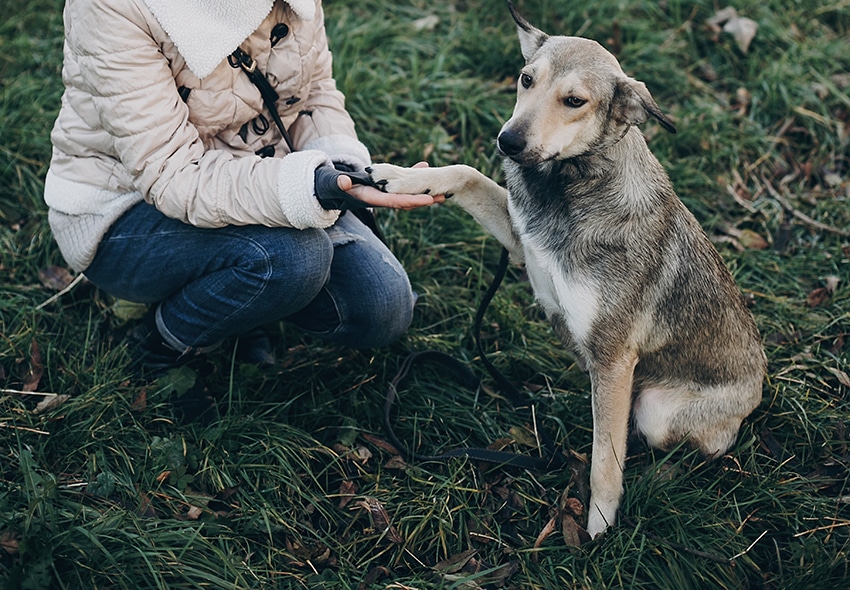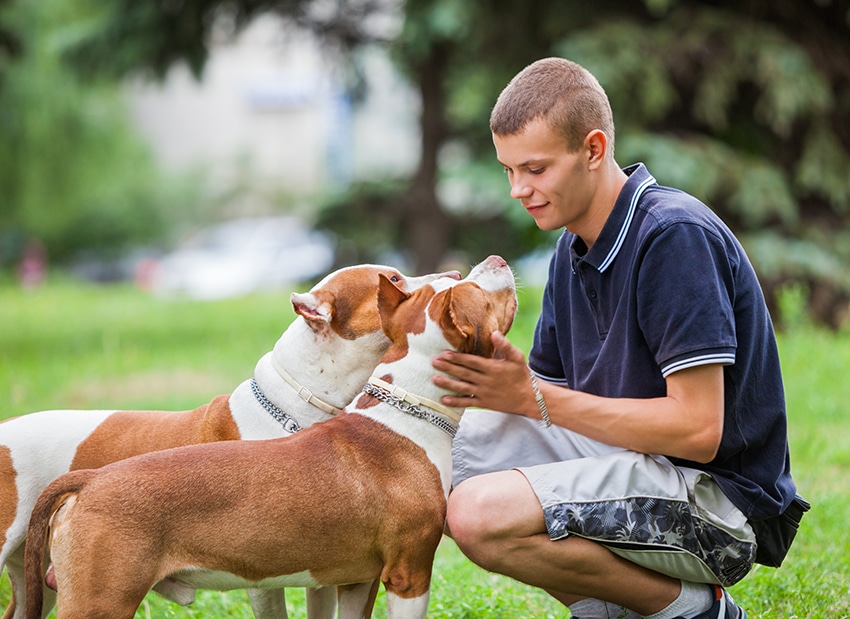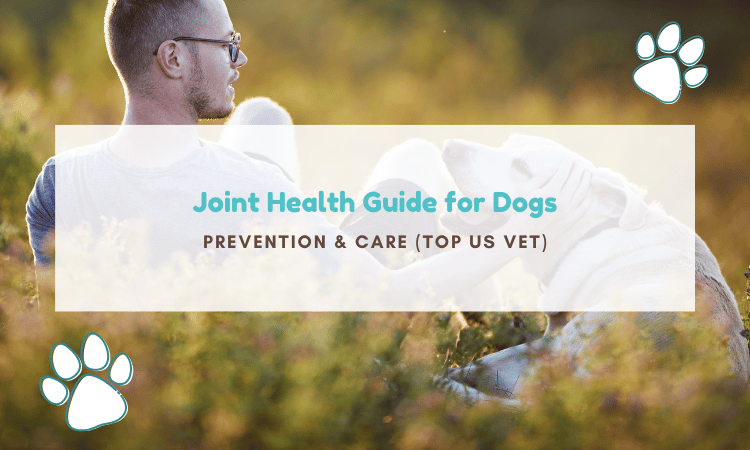As our beloved pups age, they may struggle with pain and mobility issues. That means joint care should be a vital component of your canine health plan. Adding joint supplements to your pal’s diet can provide his system the tools it needs to maintain or repair any damaged joint tissue.
When it comes to our furbabies, joint health care can be a challenge. About 25% of canines in the United States have arthritis of some kind. Because osteoarthritis is a degenerative disease, the prevalence increases with age. Surveys show that 20 percent of middle-aged dogs and 90 percent of older dogs suffer from osteoarthritis in one or more joints.
Once a pooch develops osteoarthritis it’s hard to halt the progression. According to James Cook, DVM, and professor of veterinary medicine and surgery at the University of Missouri-Columbia, there are two reasons for this: “One is we don’t have a cure, and the other is that we still see a progression of arthritis even after the best treatments.” That’s why preventative care and early diagnosis are so important.
If you’re wondering if and when you should give your pup joint supplements as a preventative measure, the answer depends on his breed. Some dog breeds have a higher risk of developing severe joint disease symptoms from an elbow or hip dysplasia, luxating patellas, arthritis, or general joint inflammation.

For pooches that have genetic predispositions for joint problems, consider starting supplements such as glucosamine when they turn 1 year old. By this age, the body is done growing and will slowly produce less of some of the substances that play a role in joint health. You can check this list to see if your furbaby is one of the at-risk breeds :
- American Staffordshire Terriers
- Bloodhounds
- Basset Hounds
- Bernese Mountain Dogs
- Catahoula Hounds
- Chow Chows
- Chesapeake Bay Retrievers
- Dachshunds
- French Bulldogs
- German Shepherds
- Great Danes
- Golden Retrievers
- Labrador Retrievers
- Neapolitan Mastiffs
- Norwegian Elkhounds
- Newfoundlands
- Otterhounds
- Old English Sheepdogs
- Pit Bulls
- Pugs
- Rottweilers
- Saint Bernards
- Shih Tzus
Osteoarthritis is not the only cause of joint pain in older pups. According to Preventive Vet, other reasons for joint pain and mobility issues “include degeneration of the nerves, muscle weakness and/or muscle mass loss, or even a torn cruciate ligament.”
There are so many ways that our aging pups can experience some level of joint pain and discomfort. Fortunately, there are things that we can do to help our four-footed friends age gracefully and experience the best possible quality of life. Let’s take a look:
Prevention is Key

You’ve probably heard the old saying, “the best offense is a good defense,” and that applies here. Once a dog develops a degenerative joint disease (DJD), most of the damage is irreversible. That’s why it’s important to be proactive and start supplementing for joint health before the senior years.
You see, as dogs get older, their body produces less of some of the natural building blocks of cartilage, like glucosamine. The reduction of these proteins puts our canine companions at higher risk for arthritis, hip dysplasia, and other degenerative conditions. Adding a quality joint supplement to your pal’s diet supports the body’s ability to produce enough of these proteins and can dramatically decrease the chance of developing painful joint issues.
That way, your pup is more likely to stay healthy and active in his golden years.
Keep Your Dog Active!

Just like us, exercise is a key component to overall health and well-being. Whether you’re working to prevent arthritis or to minimize its effects, it’s imperative that you keep your dog moving. Age and breed-appropriate activity helps to manage your pup’s weight, strengthen bones and muscles, and improve flexibility and movement in the joints.
As furbaby parents, it helps to understand just how important it can be to adopt preventative habits while your pooch is young. Having a daily exercise routine in place before degenerative changes set in could help combat the decline. Regular activity may also lead you to recognize when your pup starts to show signs of joint stiffness so that you can respond in a timely manner.
Some forms of exercise that are particularly helpful for our geriatric pals include:
Swimming
Swimming is an excellent low-impact activity. It allows your pooch to keep his joints moving through a range of motion. Introducing your four-footed friend to swimming when he’s young can help prevent a fear of water. Some older pups are too afraid of water to benefit from this activity.
Hydrotherapy
Hydrotherapy is one type of rehabilitation therapy that some veterinary clinics offer to orthopedic patients or pooches with arthritic conditions. The most common type of hydrotherapy is an underwater treadmill that allows your pup to exercise without putting stress on the joints.
Leash Walking
Daily on-leash walks help to keep your pooch active and maintain a healthy weight. Start with short outings of about 10-15 minutes a few times a day and slowly add to the distance until you find the optimum length for your furbaby.
Playing With Other Dogs
Dogs are social animals. As long as the play isn’t too rough, arranging for some play dates with other canines can help your pooch stay active and boost his morale.
Avoid High-Impact Activities
If your four-footed friend has arthritis pain, you should avoid high-impact activities like jumping, chasing balls or frisbees, or running. These forms of exercise put repeated concussive forces on the joints and can be debilitating for geriatric pooches.
Manage Your Dog’s Weight

Keeping your dog fit and active is just one component of your dog’s joint health, and it works paw-in-paw with a proper diet. The top cause of canine joint issues is obesity.
It negatively impacts their quality of life by placing added stress on the joints. If this pressure causes your furbaby to feel pain when he moves, he tends to become less active. The inactivity leads to added weight gain, and the cycle repeats.
You can break the cycle by providing your pooch with a healthy diet and appropriate levels of exercise. In truth, getting your pup to an ideal weight will do more to reduce joint pain than supplements. That doesn’t mean supplementation won’t help, but it’s not a miracle cure…and it won’t be effective to relieve pain if your furbaby is carrying too many pounds around.
Give Your Dog Joint Supplements

Once you have exercise and diet in place, you can add quality joint supplements for additional support.
The sooner you get ingredients like glucosamine, MSM, or chondroitin on-board, the more likely your pal will be able to enjoy walks long into his senior years.
These nutrients are essential parts of canine joint health care and can give natural pain relief, reduce inflammation, improve flexibility, and strengthen the joints and cartilage. Consider supplementing Fido’s diet with:
Glucosamine hydrochloride
Glucosamine is an amino-acid sugar compound that’s naturally found in joints and cartilage. Although the body produces this substance, your dog makes less as he ages, so providing supplements helps ensure his body has the building blocks it needs to repair damaged cartilage.
Chondroitin sulfate
Another naturally occurring substance in cartilage, chondroitin works with glucosamine to increase the body’s ability to repair damaged joint cartilage. This substance promotes water retention to keep the joint capsule lubricated and fights inflammatory enzymes that attack and break down cartilage.
Avocado soybean unsaponifiables (ASU)
ASUs are natural extracts from avocado and soybean oils. Much like chondroitin, they block the inflammatory chemicals that break down cartilage, and they also stimulate new cartilage production. Combining ASU with chondroitin and glucosamine may provide synergistic or enhanced results.
Omega-3 fatty acids
The Omega-3 fatty acids, Eicosapentaenoic Acid (EPA) and Docosahexaenoic Acid (DHA), can help reduce pain and inflammation. They block the protein molecules known as cytokines that are responsible for the inflammatory response. Some common sources of Omega-3 fatty acids include fish oil, krill oil, and green-lipped mussel extract.
Methylsulfonylmethane (MSM)
MSM is a natural sulfur compound that’s easily absorbed. It’s a key building block for cell membranes and works to rejuvenate cells and heal joints. This ingredient is also an antioxidant that helps to reduce inflammation and pain.
Natural eggshell membrane (NEM)
NEM comes from the membrane between the egg white and the eggshell. It contains several substances that support joint health:
- Amino acids that support joint elasticity
- Chondroitin
- Collagen – discussed below
- Elastin protein that supports healthy cartilage
- Glucosamine
- Growth factor B that supports cell regeneration
- Hyaluronic acid that supports joint elasticity and shock absorption
Boswellia serrata
A resin extract of the Boswellia serrata tree, this ingredient may help reduce arthritis pain. It contains chemicals called terpenes which inhibit the inflammatory chemical, leukotriene. This natural herbal remedy has been used for centuries to relieve pain and inflammation.
Collagen
Collagen is a connective tissue that the body uses to build healthy bones, muscles, skin, and joints. Providing supplemental collagen can help the body have enough material to build or repair cartilage.
Turmeric
The Indian spice turmeric contains a compound called curcumin that has several health benefits. This amazing ingredient acts as an anti-inflammatory, anti-fungal, antioxidant, antiviral, antibacterial, and anti-cancer agent. One thing to note is that the body needs black pepper or Bioperine to absorb and utilize curcumin. Look for it on the label.
Modify Your Dog’s Home Environment

Navigating the home environment can be a challenge for older dogs with joint disease.
Consider taking a walk in his paws. A few simple adjustments around the house could help soothe your pal’s anxiety and make his daily life easier:
Use orthopedic dog beds
Provide your pooch with a comfortable bed that’s close to the ground and has adequate orthopedic support. Thick bedding with memory foam and non-slip backing will help ease joint pain and make it easier for your furbaby to get back up without risking injury.
Provide non-slip surfaces
Aging pups with arthritis or other joint issues may be fearful of walking on hard, smooth surfaces like wood or tile. Place non-slip mats, rugs, or carpeting over slippery floors to help your pal’s mobility. You can also use rugs and other soft materials at the bade of furniture and the bottom of stairs to reduce the impact on the joints.
Use pet stairs or ramps
If your pal has difficulty climbing on the furniture or into the car, consider investing in a set of pet steps or a ramp. These devices will help your canine companion to access his favorite spaces with a reduced impact on the joints.
Get a dog-lift harness
Moderately to severely debilitated dogs may need assistance rising from a prone position. If your furbaby has difficulty standing or walking on his own, you can purchase a lift harness to assist him. It also comes in handy if you need to help your pooch navigate areas with slippery footing.
Consider a dog wheelchair
If your pup has extreme pain in his hindquarters that limits or restricts his movement, consider getting a dog wheelchair. Rolling carts allow dogs that can’t use their hind legs to continue exercising and enjoy a good quality of life.
Locate food and water bowls strategically
Some geriatric dogs with joint pain will be reluctant to get up and walk to the water dish. You can help prevent dehydration by placing food and water dishes near Fido’s favorite bed. Locate them where they’re easy to reach with little effort but not easy to spill.
Quality of Life Care

If you’ve ever experienced temporary or chronic aches and pains, you know that even the simplest activities can become difficult. There are some ways that you can help your furbaby feel his best and maintain a quality of life.
Grooming
Brush Your Dog
Older dogs with arthritis pain may find it more difficult to self-groom. Regular brushing will help to remove dirt and tangles from hard to reach places. It can also feel like a gentle massage that soothes aching muscles or joints.
Trim Your Dog’s Nails
Long nails can add to your dog’s arthritis pain because they alter his gait and foot structure. If your pooch struggles too much for you to trim his nails, it’s worth taking him to your vet or groomer to have it done on a routine basis.
A tip for the do-it-yourself crowd: Each toenail has a blood vessel, called the quick. If you cut the nail too short and hit the quick, you will cause pain and bleeding. Try trimming a little bit off at a time until you think the nail is short enough or you see a hint of pink in the center of the nail.
Therapy Options
Massage
There are professionals trained as canine massage therapists who can help ease your pal’s aches and pain. This ancient art involved kneading and rubbing the muscles and joints to help relieve pain and tension and promote healing by stimulating blood flow to the area. Regular treatments can help reduce pain and improve flexibility and circulation.
Canine Acupuncture
Veterinary acupuncture is fairly new to the United States, but doctors in China have been using it for centuries as part of their preventative medicine repertoire. The practice involves inserting sterile needles into specific points of the body to trigger a release of chemicals in the muscles, brain, and spinal cord. It can help to relieve arthritis and joint pain in some dogs.
Laser Therapy
Also known as photobiomodulation (PBMT), laser therapy is a painless, non-invasive treatment option for arthritis and other conditions. It involves the use of light to trigger nonthermal and nonharmful responses on a cellular level in the body. These reactions help to reduce pain and inflammation in patients with osteoarthritis. Laser therapy can also stimulate the healing of damaged tissues such as cartilage and muscle.
Stay Proactive for Joint Health

You don’t have to wait until your pooch is entering his senior years to think about joint health care. By staying proactive with prevention and care that fits your furbaby’s needs you can help him enjoy a long, happy life.


